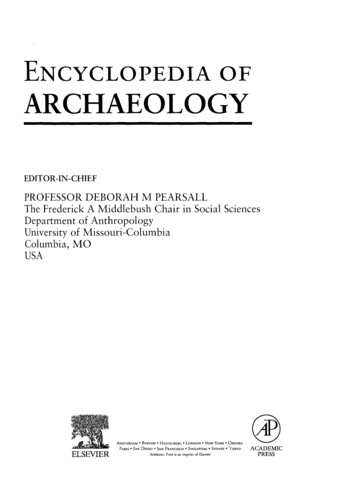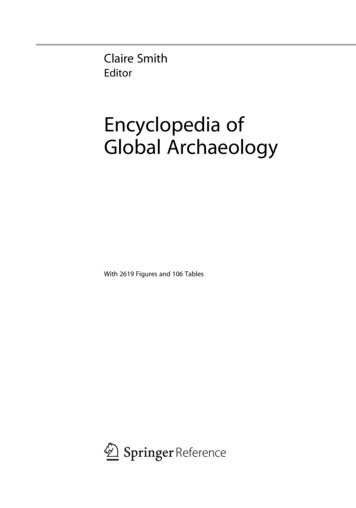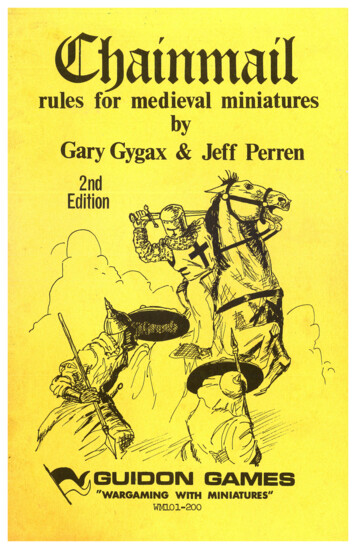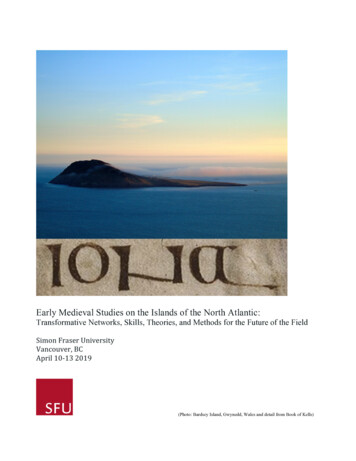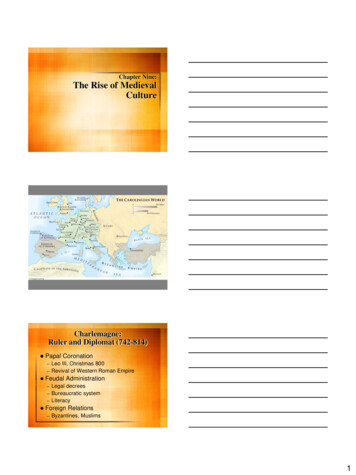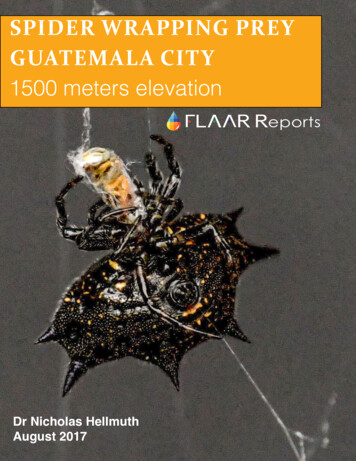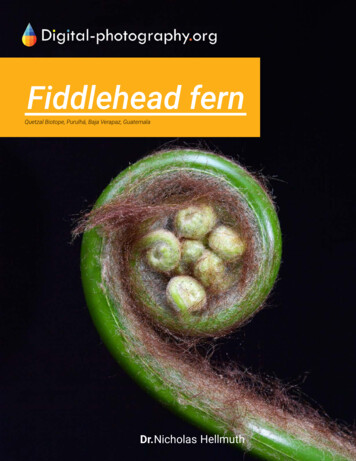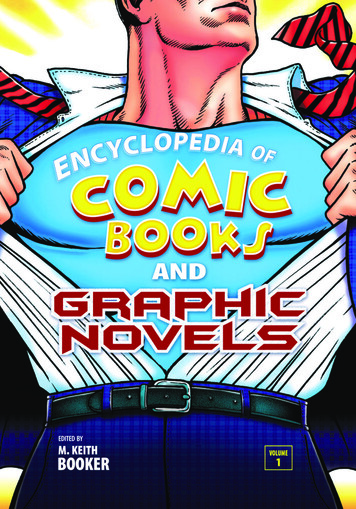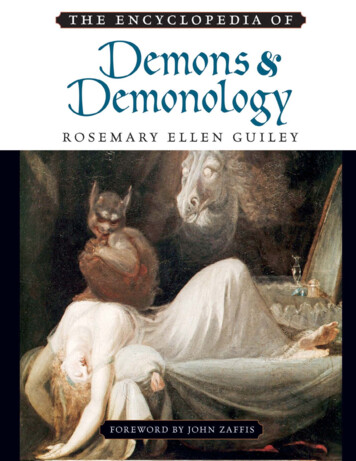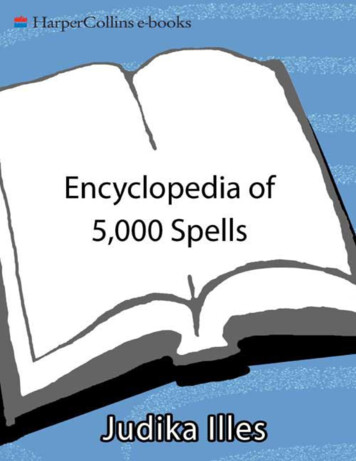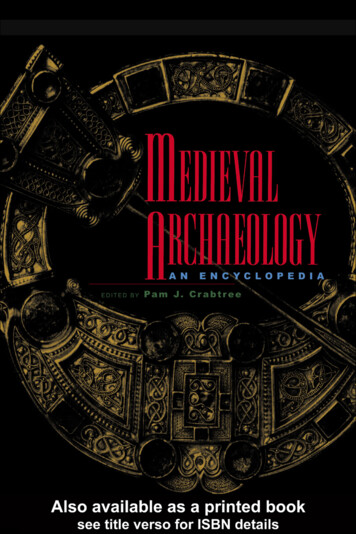
Transcription
MEDIEVAL ARCHAEOLOGY
MEDIEVAL ARCHAEOLOGY ANENCYCLOPEDIAEDITED BYPAM J.CRABTREENew York UniversityGARLAND PUBLISHING, INC.NEW YORK & LONDON2001
Published in 2001 byGarland Publishing, Inc.29 West 35th StreetNew York, NY 10001Garland is an imprint of the Taylor & Francis Group.This edition published in the Taylor & Francis e-Library, 2005.“To purchase your own copy of this or any of Taylor & Francis orRoutledges’s collection of thousands of eBooks please go towww.eBookstore.tandf.co.uk.”Disclaimer: For copyright reasons, some images in the original version of this book are notavailable for inclusion in the eBook.Copyright 2001 by Pam J.CrabtreeAll rights reserved. No part of this book may be reprinted or reproduced or utilized in any formor by any electronic, mechanical, or other means, now known or hereafter invented, includingphotocopying and recording, or in any information storage or retrieval system, without writtenpermission from the publisher.10 9 8 7 6 5 4 3 2 1Library of Congress Cataloging-in-Publication DataMedieval archaeology: an encyclopedia/edited by Pam J.Crabtree.p. cm.Includes bibliographical references and index.ISBN 0-203-80181-4 Master e-book ISBNISBN 0-203-67780-3 (Adobe eReader Format)ISBN 0-8153-1286-5 (acid-free paper)1. Europe—Antiquities—Dictionaries. 2. Archaeology, Medieval—Dictionaries.3. Excavations (Archaeology)—Europe—Dictionaries. I. Crabtree, Pam J.D125. M42 2000936–dc2100–056156
For Bernard Waileswith thanks
CONTENTSPREFACEACKNOWLEDGMENTSCONTRIBUTORSSITE ENTRIES BY COUNTRYSUBJECT GUIDEENTRIES A TO ZINDEXixxixiiixxixxiv1541
PREFACEMedieval archaeology is one of the fastest-growing fields in archaeology today. Roadconstruction and urban redevelopment have led to the discovery of new rural sites and tomajor programs of urban excavation in cities such as Winchester, York, Trondheim, andLübeck. The rich medieval archaeological database has been used to address a range ofimportant theoretical concerns in contemporary archaeology. Carefully collected faunaland floral data have been used to address problems of human economy and the naturalenvironment in the Middle Ages. Data from medieval excavations, especially whencombined with detailed documentary research, are especially well suited to addressingsome of the important issues in post-processual archaeological theory, includingquestions of gender, agency, and power. In addition, the Medieval period in Europewitnesses the origin and growth of cities, the development of long-distance trade andcraft specialization, and the formation of political states. These processes of cultural andeconomic change have been of interest to archaeologists since the days of V.GordonChilde. As a result, medieval archaeology is playing an increasingly important role inarchaeological thinking throughout the world.While medieval archaeology plays an increasingly important role in contemporaryarchaeological debate, the discipline itself remains fragmented. Although some medievalarchaeologists, especially in the United Kingdom and Scandinavia, are housed in standalone departments of archaeology or programs in medieval archaeology, many others findthemselves in departments of history, anthropology, and classics. Medievalarchaeologists also work in museums, and still others are part of ongoing archaeologicalunits or research programs. In addition, medieval archaeologists are trained in a variety ofways. Many archaeologists who work in the Dark Ages (migration period) are trained asprehistorians, while archaeologists who specialize in the High Middle Ages are oftentrained as art historians or historians. One of the goals of this encyclopedia is to bringtogether in one volume the research of a diverse range of scholars who work on a widevariety of archaeological problems.In order to accomplish this goal, medieval archaeology has been defined as broadly aspossible. The Middle Ages begin with the collapse of the Western Roman Empire in thefifth century, and end with the dawn of the Modern Era, ca. A.D. 1500. Several entriesalso address the Iron Age background to medieval society and the collapse of the RomanEmpire in the West. The geographical range is equally broad. This encyclopedia focusesprimarily on the Latin west, stretching from Poland to Iceland and from southern Italy tonorthern Scandinavia. An entry on the important medieval excavations in Novgorod,Russia, has also been included. However, the encyclopedia excludes the archaeology ofthe Byzantine world and the Balkans.This volume is designed to provide the interested reader with a guide to contemporaryresearch in medieval archaeology. It includes country and regional surveys for many
areas of Europe, entries that focus on major archaeological sites and research programs,and entries that deal with specific technologies and archaeological concepts. Forexample, the encyclopedia includes entries on dendrochronology and radiocarbon datingas well as entries on medieval cloth-making and jewelry. The entries are followed bydetailed bibliographies that include suggestions for further readings. The encyclopediaincludes a number of entries on sites and research programs in east-central Europe.Archaeological research by Czech, Slovak, Polish, and Hungarian archaeologists has notbeen widely available in English until now. These entries should be of especial interest toboth archaeological students and established scholars.In consulting the entries in this encyclopedia, it is important to remember thatarchaeology is an ongoing process of excavation and analysis. New discoveries are madeeach year, and new techniques of analysis can be applied to materials that were excavatedmany years ago. The World Wide Web is an important source for information about newdiscoveries in medieval archaeology.Pam J.Crabtree
ACKNOWLEDGMENTSThe preparation of an encyclopedia of medieval archaeology is a daunting task,especially for an American archaeologist. All of my colleagues conduct theirarchaeological research in Europe, and many also live and work in Europe. The Internetand the fax machine made this project possible. I would like to begin by thanking all mycolleagues who so graciously agreed to contribute to this encyclopedia. Without theirgenerosity and patience, this encyclopedia would never have been completed. I amespecially grateful to my colleagues for sharing the details of their ongoing research andfor providing the wonderful photographs and drawings that illustrate this encyclopedia.My colleagues and students at New York University also made this project possible. Iam particularly grateful to the students in my medieval archaeology courses in 1994,1997, and 2000 who provided support and encouragement throughout the longdevelopment of this project. My current and past M.A. and Ph.D. students contributed tothis project, and I would like to thank all of them. Special thanks go to Dr. JulieZimmermann Holt, who translated several of the German entries, and to Maura Smaleand Thalia Gray, who contributed entries. I am also grateful for the support of my friendsand colleagues at the Anthropology Department at New York University.I would like to thank Richard Steins of Garland Publishing for helping me see thisproject to completion. I would also like to thank my family—Doug, Mike, Tom, andRobby—for their support, help, and patience. And last, I will be forever grateful toProfessor Bernard Wailes, my Ph.D. advisor at the University of Pennsylvania, whointroduced me to medieval archaeology and who has supported me throughout myacademic career.Pam J.Crabtree
CONTRIBUTORSAlcock, L.Department of ArchaeologyUniversity of GlasgowAmbrosiani, B.Birka ExcavationsAmmerman, A.Department of ClassicsColgate UniversityAnderson, H.Forhistorsk MuseumMoesgårdAyres, B.Norfolk Archaeological UnitBaillie, M.G.L.Queen’s UniversityBelfastBaker, E.Bedfordshire County Archaeology ServiceBaker, N.J.School of GeographyUniversity of BirminghamBarford, P.M.Institute of ArchaeologyUniversity of WarsawBarry, T.Department of Medieval HistoryTrinity CollegeDublinBartosiewicz, L.Archaeological InstituteHungarian Academy of SciencesBatey, C.Glasgow MuseumsBlair, C.Center for Ancient StudiesUniversity of MinnesotaBonet, C.Archéologue Cantonal
Genève, SwitzerlandBusch, R.DirectorHamburg Museum of Archaeology and HistoryButler, L.A.S.Department of ArchaeologyUniversity of YorkCarlsson, D.Gotland University CollegeCarr, K.E.Department of HistoryPortland State UniversityCarver, M.Professor of ArchaeologyUniversity of YorkCejnková, D.Museum of the City of BrnoChristie, N.School of Archaeological StudiesUniversity of LeicesterClark, D.Mucking Excavation ProjectCrabtree, P.Anthropology DepartmentNew York UniversityCrumley, C.Department of AnthropologyUniversity of North Carolina—Chapel HillDaniels, R.Archaeological SectionCleveland County CouncilDix, B.Northamptonshire ArchaeologyDriscoll, S.Glasgow University Archaeological Research DivisionEgan, G.Museum of LondonEllmers, D.Director, Deutsches SchiffahrtmuseumFehring, G.City of Lübeck ExcavationsFilmer-Sankey, W.Snape Historical TrustFisher, G.Peabody Museum
Harvard UniversityGardini, A.Genova ExcavationsGelling, M.Department of Ancient History and ArchaeologyUniversity of BirminghamGibson, B.Dysert O’Dea ExcavationsGodbold, S.Westbury PressGoodburn, M.Museum of LondonGray, T.Anthropology DepartmentNew York UniversityGreene, J.P.Museum of Science and IndustryManchesterGustin, I.University of LundHaith, C.LondonHall, A.Environmental Archaeology UnitUniversity of YorkHall, D.Department of ArchaeologyUniversity of CambridgeHeckett, E.W.Department of ArchaeologyUniversity College CorkHeidinga, H.A.IPPUniversity of AmsterdamHighham, N.J.Department of HistoryUniversity of ManchesterHill, D.University of ManchesterHills, C.Department of ArchaeologyUniversity of CambridgeHindle, P.Department of GeographyUniversity of Salford
Hlavicová, J.Academia IstropolitanaHollinrake, C.GlastonburyHollinrake, N.GlastonburyHuml, V.Museum of the City of PragueJanssen, W.University of WürzburgJones, E.A.Department of AnthropologyUniversity of North Carolina-Chapel HillJones, R.H.Planning and Development ServicesBristol City CouncilKlapste, J.Institute of ArchaeologyPragueKlingelhofer, E.Department of HistoryMercer UniversityKnüsel, C.Department of Archaeological ScienceUniversity of BradfordLane, A.School of History and ArchaeologyUniversity of WalesLa Rocca, C.Department of HistoryUniversity of PaduaLegoux, R.Nantes, FranceLoskotivá, I.Museum of the City of BrnoMacDonald, K.Institute of ArchaeologyUniversity CollegeLondonMacDonald, R.H.Cambridge UniversityMalm, G.Central Board of AntiquitiesSwedenMcCormick, F.
Queen’s UniversityBelfastMcGovern, T.H.Hunter College, CUNYMcLees, C.Norwegian Institute for Cultural Heritage ResearchMcNeill, T.Queen’s UniversityBelfastMeduna, P.Ustav Archeologické Panátkové Péce Severozápních CechMoreland, J.Department of Archaeology and PrehistoryUniversity of SheffieldMorris, C.Department of ArchaeologyUniversity of GlasgowMurphy, P.University of East AngliaMuslow, R.Kulturhistoriches Museum der Hansestadt RostockMytum, H.Department of ArchaeologyUniversity of YorkNewman, J.Archaeology SectionSuffolk County Planning DepartmentNice, A.Collége Jean MurmozLaonO’Connor, T.Department of ArchaeologyUniversity of YorkOttoway, P.York Archaeological TrustParczewski, S.Instytut ArcheologiiKrakowPerdikaris, S.Department of AnthropologyCUNY Graduate CenterPlachá, V.Mestské MúzeumBratislavaQualmann, K.
Winchester Archaeological UnitRacinet, P.Université Paris-NordRackham, O.Corpus Christi CollegeCambridge UniversityRedknap, M.School of History and ArchaeologyUniversity of WalesRenoux, A.Université du MaineRoberts, C.Department of Archaeological SciencesUniversity of BradfordRoesdahl, E.Department of Medieval ArchaeologyAarhusRogerson, A.Norfolk Landscape ArchaeologyRötting, H.Neidersächsisches LandesverweltungsamtRybina, E.NovgorodRynne, C.Department of ArchaeologyUniversity College CorkSabo, K.University of LundScott, B.Program in Ancient StudiesUniversity of MinnesotaSmale, M.Anthropology DepartmentNew York UniversityStahl, A.University of MichiganStephan, H.G.Seminar für Ur—und Frühgeschichte der Georg-AugustUniversitätStopford, J.Department of ArchaeologyUniversity of YorkSveinbjarnardottír, G.LondonTaavitsainen, J.-P.
National Board of AntiquitiesHelsinkiTabaczyński, S.Institute of Archaeology and EthnologyPolish Academy of SciencesTeBrake, W.Department of HistoryUniversity of MaineThurston, T.Department of AnthropologyUniversity of Wisconsin-MadisonVan de Noort, R.Humber Wetlands ProjectUniversity of HullVan Doornick, F.Department of AnthropologyTexas A&M UniversityVerhoeven, A.Instituut voor Prae-en ProtohistoireUniversity of AmsterdamVermeulen, F.Universiteit GentVince, A.City of Lincoln Archaeology UnitWade, K.County ArchaeologistSuffolkWard, S.Field Archaeological OfficerChester Co. CouncilWells, P.S.Department of AnthropologyUniversity of MinnesotaWicker, N.Art DepartmentMinnesota State University, MankatoWollett, J.Anthropology DepartmentCUNY Graduate CenterWorthington, M.University of ManchesterWrathmell, S.Skipton, North YorkshireYoon, D.Anthropology Department
CUNY Graduate CenterYoung, B.History DepartmentEastern Illinois University
SITE ENTRIES BY COUNTRYCzech l dBoss HallBristolCadbury CastleChesterGlastonburyGrove PrioryHamwicHartlepoolHyde AbbeyIpswichLondonMuckingNorton PrioryNorwichOffa’s DykeRaunds Area ProjectShrewsburySnapeSpong HillSutton HooSutton Hoo Regional SurveyThetfordTintagelWarden AbbeyWat’s Dyke
West StowWharram ourt-les-PierrepontHerpesMont DardonQuentovicSaint-Nicolas mmaunItalyGenoaVe
Medieval archaeology: an encyclopedia/edited by Pam J.Crabtree. p. cm. Includes bibliographical references and index. ISBN 0-203-80181-4 Master e-book ISBN ISBN 0-203-67780-3 (Adobe eReader Format) ISBN 0-8153-1286-5 (acid-free paper) 1. Europe—Antiquities—Dictionaries. 2. Archaeology, Medieval—Dictionaries. 3. Excavations (Archaeology)—Europe—Dictionaries. I. Crabtree, Pam J.
